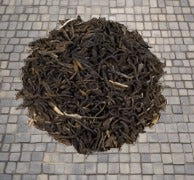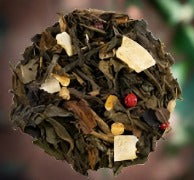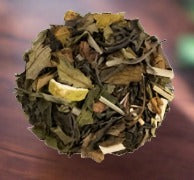Collection: White TEA
White TEA has a rich history dating back to the Song dynasty in China (960-1279) when it was considered a precious commodity by rulers. It was reserved for the nobility for a long time before it became more widely available. Nowadays, white tea is appreciated for its smoothness and slightly sweet flavor, sometimes scented with ingredients such as jasmine.
How is White TEA made?
White TEA is a type of tea made using leaves from the Camellia sinensis plant. It has a delicate flavor and is naturally low in caffeine. It is harvested at the start of the season, and is comprised of buds and new leaves. The tea gets its name from the white fuzz on the young leaves that helps protect the tea plant's new growth from insects. White tea is only withered and lightly rolled to make the tea. It is extremely light, pale-colored or blush-toned and characterized by mellow floral-fruity flavors. It is delicate in flavor and lacks the astringency and grassiness of black tea and green tea. White tea has potential health benefits that include weight loss, improved skin, and reduced inflammation.
White tea is harvested in spring between the end of March and the beginning of April. The first harvest, referred to as the Imperial harvest, involves selecting the youngest shoot and first leaf from the top of the tea plant. During the second harvest, called Fine or Classic, shoots with the next two leaves are picked. The production process for white tea is quite simple and doesn’t require much handling: it is left to wither and then dried to reduce moisture content. White tea leaves are not pressed or rolled, which helps retain their original smoothness with a fresh, slightly sweet flavor.
Among top-quality white teas, Yin Zhen (Silver Needle) and Pai Mu Tan (White Peony) are considered some of the best teas in the world. The name Silver Needle comes from the light-colored down hairs that cover the tea shoots.
How is White TEA made?
White TEA is a type of tea made using leaves from the Camellia sinensis plant. It has a delicate flavor and is naturally low in caffeine. It is harvested at the start of the season, and is comprised of buds and new leaves. The tea gets its name from the white fuzz on the young leaves that helps protect the tea plant's new growth from insects. White tea is only withered and lightly rolled to make the tea. It is extremely light, pale-colored or blush-toned and characterized by mellow floral-fruity flavors. It is delicate in flavor and lacks the astringency and grassiness of black tea and green tea. White tea has potential health benefits that include weight loss, improved skin, and reduced inflammation.
White tea is harvested in spring between the end of March and the beginning of April. The first harvest, referred to as the Imperial harvest, involves selecting the youngest shoot and first leaf from the top of the tea plant. During the second harvest, called Fine or Classic, shoots with the next two leaves are picked. The production process for white tea is quite simple and doesn’t require much handling: it is left to wither and then dried to reduce moisture content. White tea leaves are not pressed or rolled, which helps retain their original smoothness with a fresh, slightly sweet flavor.
Among top-quality white teas, Yin Zhen (Silver Needle) and Pai Mu Tan (White Peony) are considered some of the best teas in the world. The name Silver Needle comes from the light-colored down hairs that cover the tea shoots.
-
 Sold out
Sold outVietnam Mao Feng 20 Gr
Regular price €6.45 EURRegular priceUnit price / per -
 Sold out
Sold outOrange Chai 20 Gr
Regular price €7.25 EURRegular priceUnit price / per -
 Sold out
Sold outGift of the Gods 20 Gr
Regular price €5.45 EURRegular priceUnit price / per



